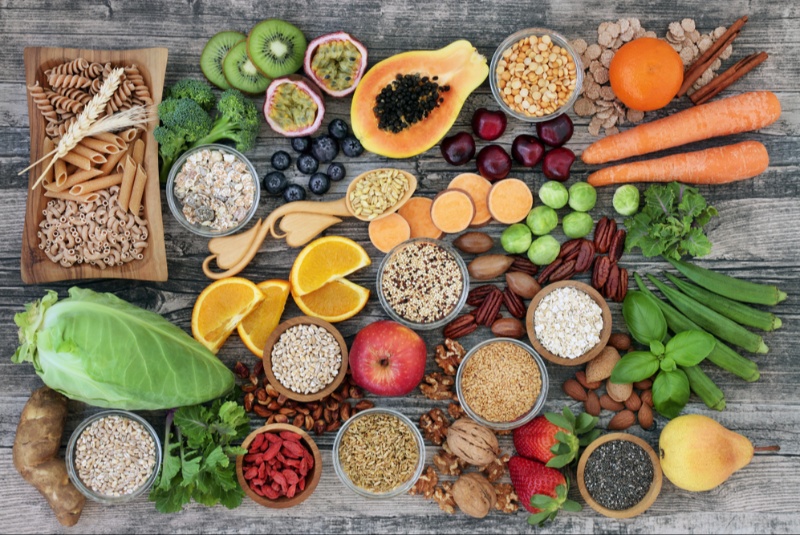Fiber is a crucial component of a healthy diet, offering a myriad of benefits that extend far beyond just aiding digestion. It is a type of carbohydrate that the body cannot digest, found in the plants we consume such as fruits, vegetables, grains, and legumes. Unlike other carbohydrates that are broken down into sugar molecules, fiber passes through the body undigested, helping to regulate the body’s use of sugars, keeping hunger and blood sugar in check. This unique characteristic of fiber makes it an indispensable part of a nutritious diet, contributing to health and wellness in several significant ways.
The Role of Fiber in Digestive Health
Fiber plays a pivotal role in maintaining digestive health. It increases the weight and size of your stool and softens it, making it easier to pass and reducing the chance of constipation. If you have loose, watery stools, fiber can also help to solidify the stool because it absorbs water and adds bulk to the stool. For those suffering from hemorrhoids or have had small pouches form in the colon (a condition known as diverticular disease), fiber has been shown to decrease symptoms and improve bowel movements. The digestive system is kept more regular and healthy when a diet rich in fiber is consumed, reducing the risk of developing various conditions, including colorectal cancer.
Fiber’s Impact on Heart Health
Fiber’s benefits extend to the heart as well. A diet high in fiber can lower your risk of heart disease and stroke by helping to reduce blood pressure and cholesterol levels. Soluble fiber, found in oats, beans, lentils, and some fruits and vegetables, helps to lower total blood cholesterol levels by lowering low-density lipoprotein, or “bad,” cholesterol levels. Studies have shown that increasing fiber intake, particularly soluble fiber, can reduce levels of bad cholesterol and have a positive effect on heart health. Additionally, fiber can improve other risk factors for cardiovascular disease, including reducing inflammation and blood pressure.
Weight Management and Fiber
Incorporating fiber into your diet can also aid in weight management. High-fiber foods tend to be more filling than low-fiber foods, so you’re likely to eat less and stay satisfied longer. This can help with weight control or weight loss. Because high-fiber foods are less energy-dense, which means they have fewer calories for the same volume of food, they allow you to eat the same amount of food but with fewer calories. Moreover, the presence of fiber in the digestive system slows down the absorption of nutrients, including sugars, which can help control appetite and prevent overeating.

Fiber and Blood Sugar Control
For individuals with diabetes, fiber is particularly beneficial in managing the disease. High-fiber foods can help to slow the absorption of sugar and improve blood sugar levels, a key factor in controlling diabetes. Soluble fiber, in particular, has been shown to have a significant effect on blood sugar levels. By incorporating foods high in soluble fiber into their diet, individuals with diabetes can better manage their blood sugar levels and potentially reduce their dependence on insulin.
How Much Fiber Do You Need?
The amount of fiber needed depends on age and sex. Women under 50 years old should aim for at least 25 grams of fiber per day, while men under 50 need at least 38 grams. For women and men over 50, the fiber need decreases to 21 and 30 grams per day, respectively, due to decreased food consumption. However, most people consume far less fiber than is recommended, leading to potential health issues that could be mitigated by a higher intake of fiber-rich foods.
Sources of Fiber
To increase your fiber intake, look towards whole fruits, vegetables, whole grains, legumes, nuts, and seeds. Refined or processed foods, like canned fruits and vegetables, pulp-free juice, white bread, and pastries, have lower amounts of fiber, so opting for whole or less processed options is key. Incorporating a variety of fiber sources can also help ensure you get a blend of the different types of fiber (soluble and insoluble), along with a wide range of vitamins, minerals, and other beneficial nutrients.
Tips for Adding More Fiber to Your Diet
Adding more fiber to your diet can be simple. Start by swapping white bread, pasta, and rice for whole-grain alternatives. Snack on fruit, vegetables, nuts, and seeds instead of chips or cookies. Also, consider incorporating legumes into your meals a few times a week and aim to eat at least 5 servings of fruits and vegetables daily. When increasing fiber intake, it’s important to do so gradually to allow your digestive system to adjust, and increase your water intake to help fiber move through your digestive system more easily.
Fiber is a fundamental component of a healthful diet with wide-ranging benefits. From improving digestive health and heart health to aiding in weight management and controlling blood sugar levels, the positive impacts of fiber are vast. Despite its critical role in maintaining and improving overall health, many people do not consume the recommended daily intake of fiber. By making simple dietary changes and opting for whole, unprocessed foods, it’s possible to increase your fiber intake and reap the numerous health benefits it offers. Remember, a healthy diet rich in fiber is not just about preventing disease; it’s about creating a foundation for a vibrant, energetic life.


